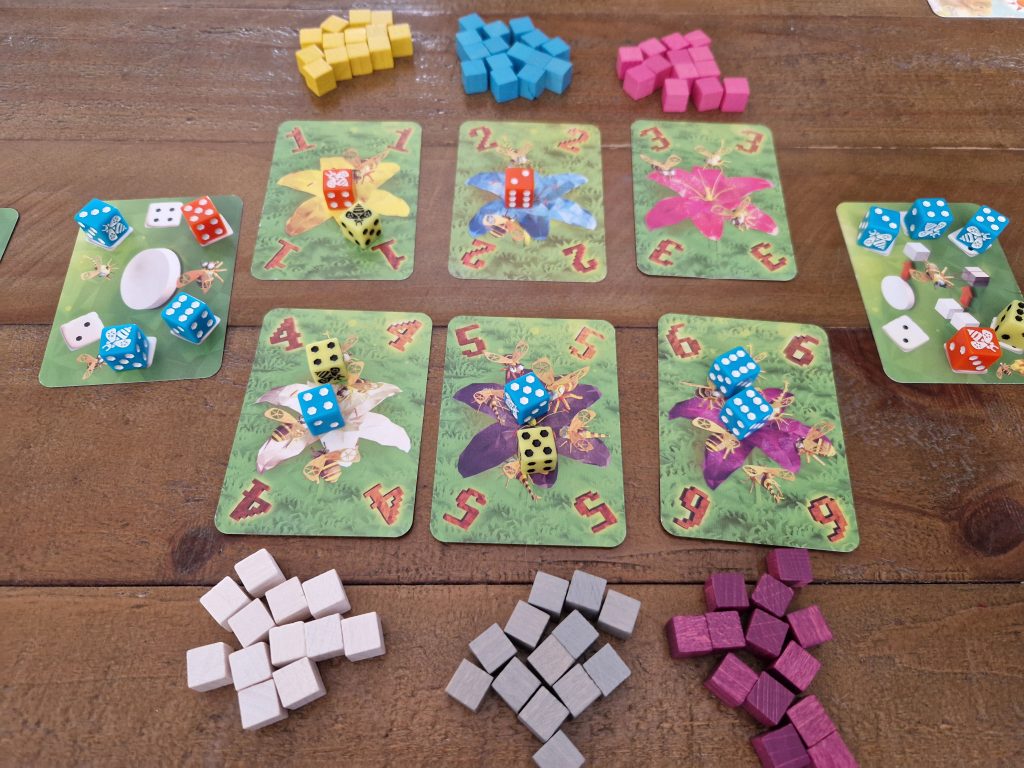Waggle Dance Review: A Good Introduction To Worker Placement Games
I’ve been trying to get the family board gaming group into worker placement games. I picked up a copy of Apiary, which appeals to me a lot. But, in the interest of not scaring my daughter and partner off straight away, I decided I needed to find something a little lighter. A little easier to pick up. Enter Waggle Dance.
Waggle Dance Quick Rules
One of the joys of Waggle Dance is the simple rules. Games are relatively short, lasting about an hour, dependent on player numbers. You generally get through half a dozen or so rounds, with each round consisting of a day phase and a night phase. The game ends when a player reaches a given number of victory points. 7 for a standard game, 5 for a short game, and 9 for a long game.
Daytime
Waggle Dance is a dice worker placement game for 2 to 4 people. Players roll a handful of worker bees. During the day phase, send the bees out to perform tasks like expanding the hive, caring for eggs, collecting nectar, preparing the hive for honey, and winning the favor of the Queen.
Nighttime
Once all players have placed their bees, the game moves to the night phase. This is when the bees reap the rewards for their daytime efforts.
Eggs are laid, which gives an extra worker bee dice to roll. Pollen gathered during the day is placed on available beehive sections. And, importantly, beehive hexes are converted to honey if they have the nectar and appropriate bees.
The Winner
Honey hexes are important because the winner of a standard game is the first player to have 7 honeycomb sections. You can also opt for a short game, with a target of 5, or an extended game, where the target is 9. At standard length, the game feels just about right.
The Game Components
The game itself is pretty. There’s a ton of dice, which are well-themed. An image of a bee replaces the number 1. And rather than circular pips to represent the numbers, the dice use honeycomb hex shapes.

Rather than a board, the game uses a combination of cards, representing the actions that players can take. The iconography on the cards is easy to understand, and once you’ve played a game, you should know what each card does.

The hives are made up of hexes, which are not only a good representation of beehive architecture but are beloved by all board gamers.
Easy To Learn
The rules are easy to pick up and you should get to grips with how everything works by the end of your first game. But, Waggle Dance still has some depth to it. As well as working out your best placement, you’ll want to check out other players’ bees to figure out their likely moves, enabling you to get in there first, or screw them over.
2 Player Waggle Dance
Waggle Dance is a good introduction to the worker placement mechanic and especially to dice worker placement. However, while it does play two to four players, it is best at a 3 or 4 player count. We started with two people, and as a 2 player worker placement game, it struggles a little.
Neutral Dice Placement
For 2 players, the rules have you roll one of the unused sets of dice to block off certain positions on cards A, C, E, and G. You end up with 3 dice on each of these cards before you start. It does help increase competition for actions but because it’s done before you start playing it kind of messes with the turn-based flow of the game.
And, the instructions might have been updated since our version was printed, but they aren’t entirely clear. I have found a more in-depth explanation on BGA which explains that any specific number should only be blocked twice over the four action cards. So, if cards A and C have the number two blocked off and you roll a number 2 for E or G, you should reroll. This prevents cases where you have no viable actions to play when you roll a blocked-off number.
Nectar Card Competition
Our rules also say nothing about putting blockers on the nectar cards. This means, with two people, there is no competition for nectar. Because it doesn’t matter what color nectar you collect, it’s very easy to gather what you need. As a result, competition is lacking and it renders the trade action card virtually useless, too. A workaround is to roll four more neutral dice and place them on the respective nectar cards at the beginning of each round.
I’ve read other reviews of the game that mention this rule being in place, so it may have been added to later prints. If not, it’s worth adding as a table rule.
Waggle Dance Conclusion

Despite those minor problems, we enjoyed Waggle Dance with two players. It will come to the table again at that player count. It’s a good introduction to worker placement games. The rules are easy to pick up but there’s still enough strategy to keep you entertained. The game comes into its own at higher player counts, when the competition hots up and there’s more opportunity to do the dirty over family members and table mates. And that, let’s be honest, is what makes worker placement games great.




